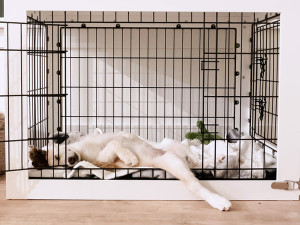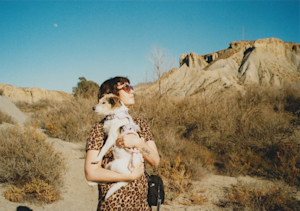The Easiest Way to Crate-Train an Older Dog
Yup, it’s totally possible. Here’s how.
In This Article:
Can You Crate Train an Older Dog? Tips for Crate Training Your Adult Dog How to Crate Train an Older Dog How Long Does It Take to Crate Train an Older Dog? Addressing Challenges in Crate Training Older Dogs What to Do if Crate Training Your Adult Dog Isn’t Working
Crate-training refers to acclimating your dog to an indoor canine crate (kind of like a metal-wire kennel). Your dog will spend time in the crate when you’re out and when you’re at home. When crate-training is done properly, your dog will consider the crate to be a safe, secure place that they can retreat to when they want some comfort. That means they may even go in there deliberately, rather than needing to be told to stay in their crate.
Although crate-training is more often associated with puppies, there are many reasons to consider crate-training an older dog. Below, we detail those reasons, as well as how to teach an older dog the new trick of finding comfort in a crate.
Trick question: All dogs are perfect! But find out which type is the best fit for you.
Main takeaways
It’s possible to crate-train an older dog, even if it takes a little longer to build a positive association with the crate.
Some older dogs might have negative associations with the crate that make training a little more difficult.
It’s important to get the correct size crate for your older dog.
Can you crate-train an older dog?
People often turn to crate-training to keep puppies from messing up their homes or to give a new dog a safe place to sleep. But crate-training can also be useful for older dogs if they’re new to your home or if there’s a change in your routine.
How much do you spend on your pet per year?
Diane Kasperowicz is a dog trainer and behaviorist with more than 15 years of experience. “Crate-training can be a hugely valuable management protocol to use and can be used with any dog, any age, any breed,” she says. “Building a positive association with the crate is essential and this can be done in a number of ways.”
Tips for crate training your adult dog
The main difference between puppies and older dogs? Puppies are, well, pretty small. Kasperowicz says that the most important thing to consider when crate-training an older dog is their size. “You must make sure you have the correct size crate,” she says. “Your dog should be able to sit and lie down comfortably and be able to turn around.” Otherwise, a confined crate may feel like a punishment.
With that in mind, says Kasperowicz, “Building a positive association is key. Feed your dog in their crate. Put treats in their crate at random times. Load a closed crate with lots of fun things like treats and toys. When your dog wants to get in and is scratching at it, let them in and enjoy the treats, chews, and toys.”
How to crate-train an older dog
Choose the right location for the crate.
When crate-training an older dog, it’s essential to choose the right location for their crate. Do they already have a favorite spot, like by the fireplace or in the corner? If so, it should be easy to choose the right location. If not, pick a spot with lots of visibility that’s warm, comfortable, and safe. Don’t shove the crate into an unpleasant corner for aesthetic reasons.
Gradually introduce your dog to the crate.
When introducing your dog to the crate, it’s important to go slowly and avoid making them nervous. Kasperowicz says that you need to take time to build up the crate’s value and safety for your dog. “The dog needs to feel happy and comfortable in the crate. Please bear in mind that not all dogs like the crate,” Kasperowicz says. This is especially true for older dogs. “Some dogs really don’t like physical confinement. And some older dogs, such as rescue dogs, may have a negative association with their crate from their previous home. So always go gently with your dog.”
Establish a routine.
You need to create a structure around when you want your dog to use the crate. If you’re planning on leaving them in it for a longer period of time, establish a routine wherein you ease them into the crate slowly after they go to the bathroom — perhaps letting them play in there a while, before shutting the door. By sticking to the same routine every day or night, you can soften their expectations of going into the crate. With time, they might even be excited for crate time.
Create a positive association with the crate.
Some dogs, particularly older or rescue dogs, might not have a positive association with crates. So it’s essential to work on that because the last thing you want is for them to associate the crate with punishment or confinement. Says Kasperowicz, “My favorite way of building a positive association is to let your dog see you place lots of treats and fun things in the crate without allowing access to it.” She adds, “Having the doors closed and dropping treats through the bars is easy. Your dog will really want to get in there, and building a little bit of frustration can mean that your dog is super keen on wanting to go in.” Once they are begging to get in, says Kasperowicz, you can open the door and let them enjoy their treats in the crate. However, she adds, “Don’t close the door yet. They need to feel safe and that you’re not going to shut them in for this exercise.”
How long does it take to crate-train an older dog?
The length of time it takes to crate-train an older dog depends, Kasperowicz says, entirely on the dog, their experiences, and their association with being in the crate. “Some dogs will learn to love their crate quickly. For others, it may take a few days or weeks,” she explains. Overall, you need to remember to be patient.
Addressing challenges in crate-training older dogs
Barking and whining
You may find that your dog has an aversion to the crate, perhaps due to a negative association from their previous home. If they tend to bark or whine in the crate, slow down the training and don’t shut them in too soon. Make them feel as if they can leave the crate whenever they choose.
Crate anxiety
If your older dog has crate anxiety, Kasperowicz says that you need to take your time and understand that you haven’t failed. “Not every dog will like their crate no matter how much training you put into it,” she says. You can try different types of crates, such as a fabric one. You can try covering it with a blanket or leaving it uncovered. With time and different approaches, you should be able to help them get over their anxiety.
Crate aversion
If your dog is averse to their crate, you can’t force them into it. However, you can continue to try and make it a positive space, offering them their food, toys, and treats in the crate. Eventually, they should go into it of their own accord.
What to do if crate-training your adult dog isn’t working
If your older dog just can’t seem to get used to the crate, their crate-related trauma may be too deep-rooted. Try leaving it open and treat it as their bed for a while, but in the rare case that doesn’t work, you may have to consider alternatives.
Bottom line
Overall, crate training an older dog isn’t so dissimilar from crate training a puppy.
However, older dogs may have hang-ups around their previous experiences in a crate.
With time and patience, they will learn that they’re safe and secure in the crate.
FAQs
What’s different about training an older dog?
The main difference between training an older dog and a puppy is that an older dog may have trauma and hang-ups which make it more difficult to build positive associations. However, over time, they will more than likely learn to like their crate.
How to crate-train an older dog with separation anxiety?
If your older dog has separation anxiety, they may benefit from being crate-trained. “However, some dogs can become more anxious when left in a crate. It really does depend on the individual dog,” Kasperowicz says. Most importantly, when training a dog with separation anxiety, you need to be patient and consistent.
What age is too late to crate-train a dog?
It’s never too late to crate-train an older dog — or teach them anything, for that matter. Just make sure they don’t have any regular medical needs, which means they can’t be left in a crate overnight.
How to train an older dog to sleep in the crate at night?
If you are trying to train your older dog to sleep in a crate at night, Kasperowicz recommends keeping the crate in your bedroom first. “This builds a positive association and helps the dog sleep through the night because they can hear you, smell you, and feel close to you,” she says. “Initially, we want to build a strong, safe attachment to you by the dog being with you overnight. After a few weeks, you can then gradually move the crate towards the door and out of the bedroom, to the crate eventually being in the room you want it, ie the kitchen/utility/living room.”
What type of crate is best for crate-training an older dog?
There are many options for crates: metal, plastic, and fabric. Kasperowicz says you need to consider your individual dog’s needs. “If the dog is sound sensitive they may not like a heavy, metal crate. If it has a negative association in a previous home to a metal crate, you may want to try a plastic or fabric crate instead,” she says. However, if you have a chewer, fabric might not work. You also need to think about convenience — if you travel with your dog regularly, you need a car-safe crate.







